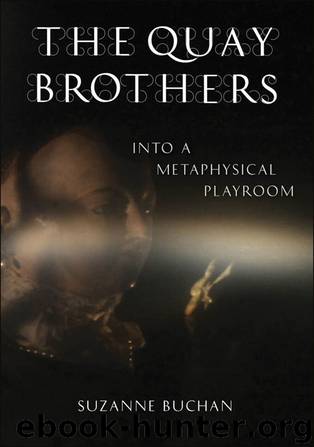The Quay Brothers: Into a Metaphysical Playroom by Suzanne Buchan

Author:Suzanne Buchan [Buchan, Suzanne]
Language: eng
Format: epub
Publisher: University of Minnesota Press
Published: 2011-03-07T08:00:00+00:00
Figure 11. The Schulz puppet glimpsing a series of minor epiphanies: the Schulzian “ascension of the everyday.”
This lostness is apparent in the long, dense, and associative Metaphysical Museum montage sequence. Following a short sequence of hard cuts that confirm the Schulz puppet in a new diegetic space, a fade-in to an image is immediately followed by a fade-out. This cuts to a framed close-up shot of the puppet identical to two later shots suggesting, in conventional terms, a flashback, dream, or memory and functioning as a transition to the following sequence. Objects and mise-en-scène elements that have been scattered throughout the film are brought into a shared context here. The puppet is drawn to the flickering light of a small, dust-encrusted window. Through a small opening, images of pulleys, wires, ice cubes, and dandelion clocks keep the puppet’s gaze imprisoned. He appears three times in extreme close-up in a point-of-view shot of the side of his face as he looks through the window, shot from a camera position outside the theater of objects (see Figure 11). This is different from the shot-countershot between his gaze and the objects’ location. This montage sequence is composed mainly of fades and fast pans, enhanced with a technical, self-reflexive animation “subtext” (water forming into an ice cube, dessicated dandelion clocks reassembling themselves to gossamer globes). All hard cuts involve our seeing the puppet and the objects from his point of view; fades and fast-pan shifts are assigned to the objects that we assume are in his field of sight. Yet repetitions, eye-line matches, and crosscutting of previous images with new images and with close-ups of the puppet suggest a new set of relations that is extremely difficult to disentangle in the short time period in which they are projected. For instance, there is a long shot of the Schulz puppet seen through an opening: is he watching himself? These seem to be examples of what the Quays propose, that “there could also be analogic spaces, created in the editing process, or abstract spaces, created by massive close-ups and deficient depths of focus—by violations of scale.”28 Some transitions are eye-line matches from the puppet’s point of view through the peephole, and other transitions are in spaces that we have seen before; and as the spatial relations of the Zone in which the puppet is standing have been explained, they would be impossible for his eye to see from his position. These “analogic spaces” are also created in other sequences sharing similar montage and camera techniques (2:11–2:29, 6:45–7:00, 9:37–9:57). All seem to be representing subjective states of mind, or, perhaps more so, they represent the “laws” of the film’s world. The Quays’ enigmatic films leave viewers with multiple choices: the co-creational opportunities offered in their cinematic equivalents to Joyce’s literary dislocutions, and differing degrees of lostness and disorientation, with accompanying degrees of pleasurable apprehension and eventual comprehension. It is possible to simply enjoy the flow of images, or to try to find meaning or a schemata
Download
This site does not store any files on its server. We only index and link to content provided by other sites. Please contact the content providers to delete copyright contents if any and email us, we'll remove relevant links or contents immediately.
| Acting & Auditioning | Broadway & Musicals |
| Circus | Direction & Production |
| History & Criticism | Miming |
| Playwriting | Puppets & Puppetry |
| Stage Lighting | Stagecraft |
Call Me by Your Name by André Aciman(19010)
Ready Player One by Cline Ernest(12885)
How to Be a Bawse: A Guide to Conquering Life by Lilly Singh(6713)
Wiseguy by Nicholas Pileggi(4616)
The Kite Runner by Khaled Hosseini(4493)
On Writing A Memoir of the Craft by Stephen King(4233)
The Crown by Robert Lacey(4122)
Audition by Ryu Murakami(4117)
Call me by your name by Andre Aciman(4089)
Harry Potter and the Cursed Child: The Journey by Harry Potter Theatrical Productions(4001)
Gerald's Game by Stephen King(3937)
The Perils of Being Moderately Famous by Soha Ali Khan(3794)
Dialogue by Robert McKee(3600)
Dynamic Alignment Through Imagery by Eric Franklin(3507)
Apollo 8 by Jeffrey Kluger(3208)
How to be Champion: My Autobiography by Sarah Millican(3199)
Seriously... I'm Kidding by Ellen DeGeneres(3110)
Darker by E L James(3096)
The Inner Game of Tennis by W. Timothy Gallwey(3011)
